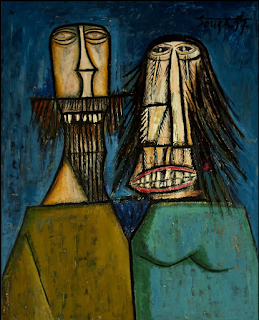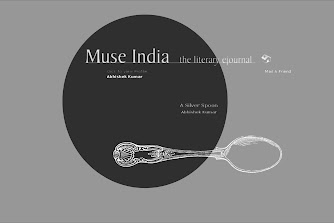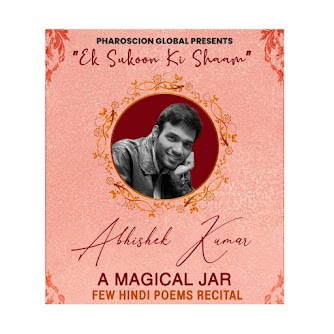CANVAS OF THE GROTESQUE
January 11, 2017
( Cave painting of a Bison in Spain)
“Art is to be seen, not talked about”, when Pablo Picasso, the most celebrated cubist artist, quoted art as a subject of understanding and not of explanation, he spoke for the art that might need the crutches of verbal description. Art, in particular, painting, is the record of civilization’s evolution on several social levels. If I can persuade you to take a brief look at the chronological art timeline and feast on the exuberance of various art movements that evolved through history, I will be delighted. But again, in some sense, I will be defying Picasso and his view about art’s perception. I am rather going to talk about art as a subject of subjectivity.
Art has always been there, from the painting in the Caves to the elucidations in Sistine Chapel to the pictures in newspapers and hoardings, it is an indispensable part of human society. Although what art holds in terms of significance has varied through its journey from Caves to computers. Initially when human civilizations started documenting experiences and when there was enough comprehension in people to understand the illustrations, art was tacitly owned by religion as a medium to depict the religious epics on a broader scale. It was in the most modest term considered as a property of the elite class. Only the affluent can own art pieces which were of any significance. Classic art which evolved from painting epics to painting the rich, made the owners flaunt it as a sign of owning great wealth and each painting commissioned was very specific to the mansion or palace that it was painted for. In a way, it was a record of the people who housed such affluent properties. Eventually, the reins of art slipped from the hands of privileged few and fell on the ground amidst the general public in terms of subject and the sitters and locations transformed from the elite class to the common people and their common, ordinary lifes. Realism was the art movement which captured the reality of the working class. From paintings of Dukes and Landlord and ambassadors in classic art, artists started to paint peasants, workers, and vagabonds. It was adeptly complimented by romanticism where there was a bit of drama on display alongside the common life day to day depictions. But this was the era when the walls of rigid and well-defined art were slowly cracking.
Impressionism art movement emerged when the photographs came into existence and it was sort of a revolution against the dark colors and “plastic” pictures clicked by cameras. Impressionists took the responsibility of using bright colors to display the excellent effect of light in painting which the powerless lenses of cameras could not catch. The walls of rigid and agreeable art were broken when expressionism and surrealism came into the picture. When dreams became subjects and expressions and feelings were painted on Canvas in the form of strokes and waves and lines, the requirement of involvement of spectator or viewer increased exponentially. To the common eyes these works seem subversive and a bit childlike. Painters like Vincent Van Gogh and Edward Munch did not receive enough recognition in their lifetime but posthumous their work has been recognized as pure genius. When we moved a little further and were invariably flung into the cradle of modernism, we had cubism, abstract art, and abstract expressionism as the prominent art movements. Where cubism fragmented a picture into geometrical figures, abstract expressionism was in the pure sense to the common eyes mere splashes of paint on canvas. But if they were deeply observed and the viewer allowed himself to flow with those lines, he would embosom the warmth of the emotions that were etched on the canvas by the artist.
If I were to quote an analogy for the evolution of art, I will choose to talk about the simple similarity it shares with the evolution of science, especially from classical to quantum mechanics. On one hand, we had classical mechanics that talked about laws of gravitation and motion whose effects were easily quantifiable by common eyes and hence the substantiality of comprehension was readily available. It was possible to show an apple drop and talk about the gravitational pull. The common eyes were not required to understand complex equation to agree with the fact that there is gravitation. But on the other hand when quantum mechanics emerged, we talked about energy and waves which were not easily understood or “shown” and the common minds found it a little mystical and flabbergasting. Equations were the base of acceptance and substantiality of this evolutionary science was comprehended by a very small section of the world. Abstract art is more or less like quantum mechanics, it seems mystical and there needs a greater involvement from the viewer’s side in comparison to the usual looking at the classical art. This problem exists with poetry too. For a long time, poetry had a specific structure and there were meters to decide its applicability and importance. But most importantly, rhyming was an indispensable part of poetry. But now we have contemporary work that has embosomed blank verses where rhyming has fallen out of poetry’s canvas. Rhyming has become intrinsic and it could be blatantly found in the thoughts but not in words.
Art without definite structures and poetry without rhyming is alarming to many. We have a tendency to reject them as pieces of art in the first place. But these contemporary art forms are more open to emotional interpretations than the classical art were ever. It is the allowing of the viewer to feel his melancholy, his joy, his delusions in those undefined stripes and sprinkles and splashes is what makes abstract art so pivotal. But it is the same allowing that renders it rather mystical and unrelatable by general public. And so it is often accused of being ridiculous and irrelevant because we, the common heads, do not like to invest a lot of ourselves into something that demands pushing our boundaries of general and obvious. We always have the tendency to look for defined and ready-made explanation without much requirement of deductive thinking. Pieces of art which seem achievable by the untalented too are often deemed low in contrary to the ones that have such finish of brushes which seems like a demi-god’s work. We are, on a broader scale, influenced by complex structures and consider only defined complex artwork as actual work of art.
Indian artists like Tayeb Mehta and Francis Newton Souza painted in the simplest shapes and most subversive lines. Their work had a serious impact on the society that we freely breathe in. Symbolism which the modern art speaks of with great pride, aboded their canvases. Souza’s dedication to allow the sensual, oppressive, grotesque to creep up his canvas instigated the acceptability of the Ugly and “tabooed”. His work might seem childlike to few but it is impossible to achieve the effect it had. As a common error we have a humongous tendency to confuse the simple from the ordinary. Simple seems achievable but has an effect that is ungauged and undeniable but ordinary is only achievable. It does not have the effect simple can ever have.
So the modern art, as criticized and as debated as it may be, is only an object of seeing and exploration of the inner self. It is not to be talked about or quantified in terms of structures and definitions because making sense amidst the chaos of colors is commendable, no matter what.
( The fall of man by Michelangelo di Lodovico Buonarroti Simoni, Classic art)
( The Gleaners by Jean-Francois Millet, Realism)
( Wanderer above the sea of fog by Caspar David Friedrich, Romanticism)
(Woman with a parasol by Claude Monet, Impressionism)
( Stary Nights by Vincent Van Gogh, Expressionism)
( The persistence of memory by Salvador Dali, Surrealism)
( Guernica by Pablo Picasso, Cubism)
( Pop art by Andy Warhol)
( The Six, Abstract Expressionism)

( Abstract Expressionism)

( Francis Newton Souza)

( Francis Newton Souza)


( Falling bull by Tayeb Mehta)

( Mahisasura by Tayeb Mehta)

( Doodle art)




















0 comments